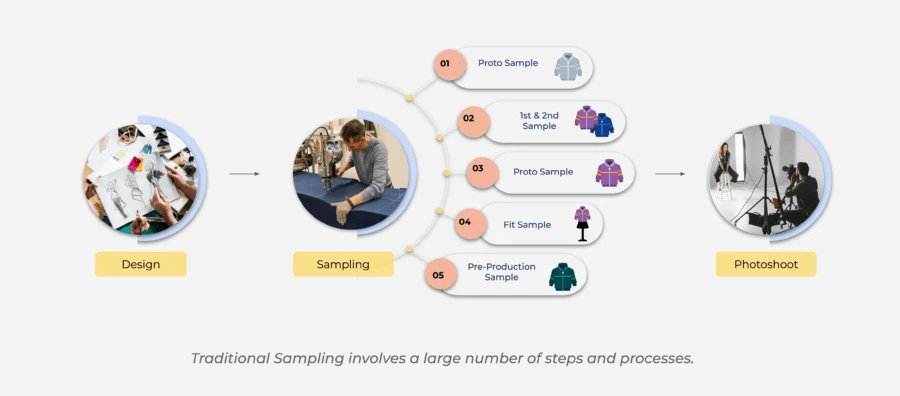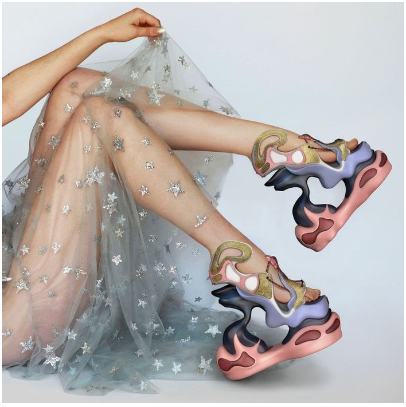Imagine. If right now, sitting where you are, you had an option to wear an extremely creative and exclusive outfit with just a few clicks on your screen, what would you do? You don’t have to think twice about the answer, right?
Now what if we say, you don’t have to imagine this. Because, what you just imagined is a reality already, thanks to the fashion industry embracing digitisation with open arms! The reasons are plenty – the lesser footfall in physical retail stores owing to the pandemic; increased focus on saving time and other resources; a need to improve the scope of creativity and uniqueness, and better ways to ensure sustainable fashion.
In case you are wondering that, even though the reasons look valid, but saying digitisation helps you achieve all of them is a bit of a stretch, give us a few minutes of your precious time to tell you why it is not.
Achieve Business Sustainability Goals Through Digital Sampling:
We all know the starting point (A) and the end point (B) of any garment ever made. A is the first design made by the designer and B is the final outfit that the customer wears. Even someone without a fashion background knows the journey from A to B is tedious, has multiple loops to pass through, and requires a lot of time if you want a happy ending.

But this is, if you take the conventional route. What if you could still reach B without the surplus hassle and make more optimum use of time? This is where digital sampling can help you. Yes, you are probably thinking to yourself – it is not that easy, there are technologies to adapt to, there’s learning to do. We agree with them all. But take a pause, and answer the question – is it worth it? We would say it is. And not only for us, for the world at large.
It is estimated that, to finish one garment, it takes about six samples. Wouldn’t it be a relief if it could take just one?
Okay, so how does it work? Once the digital prototypes of the outfits are created and sent virtually for assessment, all the iterations and customisations happen digitally without even making the physical product. All the hassle associated with multiple changes, all the to and fro, transportation, and ensuring that the outfit reaches the customer in the right shape – are all eliminated at once. So why waste weeks or months to make an outfit that the influencer is probably going to wear once or twice, when you can do it within hours?

And when we talk about time, it is only about saving the time required to produce a garment But also making sure that it reaches the target audience before the trend goes out of fashion. Digital sampling helps you achieve this without compromising the planet’s health. For instance, when a brand decides to stop producing physical samples entirely, it is saving millions of litres of water required to produce them. Millions!
With climate change not a thing of the future anymore, the fashion industry is already taking responsibility and taking necessary actions to reduce the drastic impact of the conventional supply chain. As it was mentioned as a part of the State of Fashion 2020 Covid-19 update, BoF & McKinsey, digital showrooms will persuade the industry to look for alternatives to the millions of physical samples produced. The partnership between Adobe Substance and Browzwear is a proof of leading brands moving towards producing garments in the most sustainable and efficient manner. In fact, Avihay Feld, CPO and Co-CEO of Browzwear said: “It has to be the case that the final physical product is a twin of the digital one—that’s our lighthouse.”
- Ability To Acquire A Digital Wardrobe Through Game Skins And More:
Wait. Are you thinking this digital-only clothing happened out of nowhere? And is it even a thing? Who wants only digital clothes? It is understandable that the influencers have an attraction towards it. But who else? The gamers!
The gaming world has transformed from being just a platform where you fight your opponents and score. Today the gamers want to create a virtual identity, close to their real version, and buy from brands they would associate with in real life as well. The demand is so huge that according to UX Planet, the market for “skins” in video games could reach approximately $50 billion USD by 2026. Today, a typical skin on Fortnite is in the price range – $2 and $20 USD. Extremely rare skins are even sold for thousands of dollars.

The interesting part to note here is, these skins do not affect the way the gamers play at all. They are a medium of self-expression, which shows how important it is for this generation. When you can make a mark in the online world, without a real-life equivalent, along with exploring your fantasies, why not?
With a digital wardrobe, today’s generation is making the most of it to consume fashion without the barriers of conventional fashion limitations.

- Access To Exclusivity Through NFTs:
When the need to stand out from the rest is on the rise, definitely the popularity of something like NFTs is bound to increase. While NFT can be literally for anything digital, it means a huge deal for fashion enthusiasts. If you purchase an NFT, it is sure that you own the original piece, which makes the concept of NFTs truly tempting as you get to own something exclusive.
Drinkwater says, “With the proliferation of high street stores where everybody is pumping out huge volumes, but every store is the same, it’s made the world very boring. I think the element of exclusivity that you could create through digital clothing is something that could build that desire and actually return a sense of how we used to shop.”
It couldn’t be far from the truth because according to Forbes, since November 2017, around $174 million has been spent on NFTs. The desire to own digital unique assets is quite real!
- An Enhanced Customer Experience:
When you identify the need to make physical stores more convenient, you arrange the shelves in the most appealing and convenient way, introduce features that will retain the customers in the store, and make their entire shopping experience as memorable as possible. So now when people are going to spend more time online than offline, what do you do? Make the online experience pretty awesome! Simple, right?
By 2024, Euromonitor International’s report on retail innovation predicts that global online retailing will see growth of $1.5 trillion. As the digital world becomes extremely competitive day by day, only the ones who align their business strategy with innovation and customer-centric principles will remain on top of the game.
Our virtual marketplace, which enables an immersive shopping experience, is one such avenue for you to provide your customers with the platform they deserve!
Key Takeaways:
- Sustainable fashion can be a concrete reality if more brands choose digital sampling over traditional samplings and optimise the supply chain altogether.
- Digital wardrobes will keep gaining popularity as they create opportunities for people to express themselves virtually, eliminating the barriers of conventional fashion trends.
- NFTs allow access to exclusive and unique digital assets, thereby satiating the desire to stand out from the clutter and promoting the work of artists.
- Digitisation helps in creating an immersive and seamless shopping experience through avenues like the virtual marketplace, which will lead to the retention of customers on the platform.
To help you venture into the digital revolution of the fashion industry with the right resources, we are here! Stay tuned to know more about us or reach out to us right away so that we can get the conversation started!


